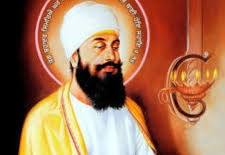Dear learner, the following essay is on Guru Teg Bahadur ji, the 9th Guru of Sikhism. Here is a 500+ word essay for you. Please read the essay and learn more about Guru Teg Bahadur.
| Name | Guru Teg Bahadur |
| Father | Guru Hargobind Singh |
| Mother | Mata Nanaki Devi |
| DOB | 01/04/1621 |
GURU TEG BAHADUR
Guru Teg Bahadur ji, the ninth Guru of the Sikh faith, left an indelible mark on history through his spiritual teachings, unwavering commitment to justice and ultimate sacrifice for religious freedom. Born on April 1, 1621, in Amritsar, Punjab, Guru Teg Bahadur’s life journey was characterized by his profound wisdom, deep compassion, and valiant stand against oppression. His life story continues to inspire countless individuals seeking spiritual guidance and a just way of life.
Early Life & Education
Guru Teg Bahadur was born to Guru Hargobind Singh and Mata Nanaki Devi. From an early age, he was exposed to the teachings of Sikhism through his family and the Sikh community. He received education not only in spiritual matters but also in several languages and scriptural traditions. His upbringing under the guidance of his father laid the foundation for his future role as a spiritual leader.
Ascension to Guruship
Guru Har Krishan, the eighth Guru passed away in 1664. This incident created a spiritual void in Sikhism. At the age of just five, Guru Teg Bahadur ji was appointed as the ninth Guru. His ascension was marked as a remarkable moment in Sikh history. He would go on to play a significant role in shaping the course of Sikhism.
Promotion of Sikh Values
Guru Teg Bahadur’s tenure as Guru was marked by his tireless efforts in spreading Sikh values like the importance of selfless service, equality and devotion to God. He continued the tradition of his predecessors by emphasizing the importance of meditation, honest living and the welfare of others. His teachings resonated deeply with both the Sikh community and those pursuing spiritual guidance.
Championing Religious Freedom
One of Guru Teg Bahadur’s most notable acts was his unwavering defence of religious freedom not just for Sikhs but for all faiths. In the 17th century, the Mughal Empire Aurangzeb sought to forcibly convert non-Muslims to Islam. The Brahmins of Kashmir facing religious persecution approached Guru Tegh Bahadur for help.
In a remarkable act of courage and solidarity Guru Teg Bahadur ji stood up against Aurangzeb’s oppressive policies. He travelled to Delhi to confront the Emperor and advocated for the right to religious freedom. He refused to convert to Islam and defended the right of the Brahmins to practice their own religion. This selfless act of sacrifice earned him the title of “Hind Di Chadar” or the “Shield of India”. He stood as a shield to protect the diverse religious fabric of the nation.
The Martyrdom
Despite his peaceful and principled stand Guru Teg Bahadur’s refusal to comply with Aurangzeb’s demands, led to his arrest and imprisonment. Along with his devoted companions like Bhai Mati Das, Bhai Sati Das and Bhai Dayala, Guru Teg Bahadur ji endured extreme torture and persecution. Yet he remained steadfast in his beliefs. The Mughal authorities hoped to break his spirit but his courage and conviction only grew stronger.
In 1675 Guru Tegh Bahadur was publicly executed in Chandni Chowk, Delhi. His martyrdom was a profound statement against religious tyranny and a testament to his unyielding commitment to the principles of justice, freedom and equality. His sacrifice inspired a spark of resistance against oppression and ultimately contributed to the downfall of Aurangzeb‘s tyrannical regime.
Guru Tegh Bahadur’s legacy
Guru Teg Bahadur’s legacy extends far beyond his time. He left a lasting impression on Sikh philosophy, emphasizing the importance of spiritual practice, humility and standing up for what is right. His teachings compiled in the Guru Granth Sahib, the holy scripture of Sikhism continue to guide and inspire millions around the world.
Guru Teg Bahadur’s martyrdom played an important role in shaping the identity of the Sikh community. His sacrifice is a symbol of commitment to upholding justice and defending the oppressed. It serves as a reminder of the importance of religious freedom and the enduring power of conviction in the face of adversity.
Conclusion
Guru Teg Bahadur’s life and teachings encapsulate the essence of Sikhism – a faith rooted in compassion, justice and unwavering devotion to God. His courage in the face of religious persecution and his ultimate sacrifice for the greater good, have left an indelible mark on human history. As we reflect on his life we are reminded of the enduring power of faith, the importance of standing up against oppression and the value of selflessness and compassion in shaping a just and harmonious society. Guru Teg Bahadur’s legacy continues to shine as a beacon of light, guiding us toward a world where religious freedom and equality are sustained for all.
Thank you for reading the essay on Guru Teg Bahadur ji. You can also read essays and biographies on-
- Raja Rammohan Roy Paragraph
- Maulana Abul Kalam Azad Biography
- Prafulla Chandra Roy Biography
- Biography of Nayantara Sehgal
- Manoj Das Biography and Selected Books
Sharing is caring. Share this essay to a friend and help him in his learning.

